BLADE was released in August of 1998, which means it came 25 years ago. It would be easy enough to say that’s what led me to rewatch it this week, but that’s not the case. The truth is that I am a person who thinks Marvel’s TOMB OF DRACULA is very likely the greatest comic book series of all time, and as I am so often prone to do, I just happened to take the first volume collecting the series off my night table, where it continually resides, to page through it again, and doing that made me think about BLADE.
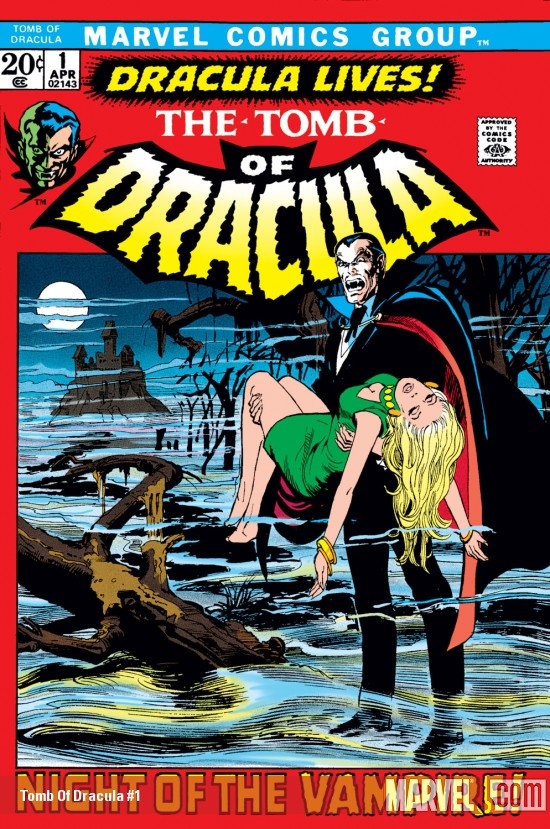
Cover by Neal Adams.
For those who aren’t tried-and-true comic-book geeks, a quick history: THE TOMB OF DRACULA came about in the 1970s, part of a horror boom which was the result of the weakening of the Comics Code Authority, which had so harshly and puritanically regulated great horror comics during the 1950s such as those published by EC Comics. (Some horror fans remember EC best from more relatively recent tributes such as George A. Romero and Stephen King’s CREEPSHOW and HBO’s Tales From The Crypt. But don’t sleep on those old comics! The artwork alone, goddamn…) Marvel Comics got into running horror comics regularly in the early 1970s. WEREWOLF BY NIGHT was first. TOMB OF DRACULA followed, along with THE MONSTER OF FRANKENSTEIN and TALES OF THE ZOMBIE. Characters like Man-Thing and Moon Knight owed more to horror than any other genre, though they often mingled with Marvel’s superheroes. In my eyes, TOMB OF DRACULA is the best of all of the Marvel horror comics of the 1970s, maybe even all the Marvel comics ever.
One reason I argue for the series’ supremacy is that it carries such a strong artistic vision. Gene Colan drew the entire series, with the great inker Tom Palmer joining at Issue #3 and contributing to nearly every issue after that. Comic book writers such as Gerry Conway, Archie Goodwin, and Gardner Fox wrote the first several issues, but once the excellently-named (especially considering the circumstances) Marv Wolfman took over with Issue #7, he stayed all the way through to the end, Issue #70 in 1979. Gene Colan is one of the great mood-setters in comic art history. His imagery in THE TOMB OF DRACULA blends the best of Marvel Comics 1960s and 1970s flash and bang with the storms and shadows of Hammer Pictures. It’s dynamic and haunting at the exact same time. Reading Dracula, the description (thin, white mustache, imposing) always made me think of James Coburn. Gene Colan picked a different gravel-voiced character actor, Jack Palance, as his model, and sure enough, Jack Palance then played the role in 1974. It’s Gene Colan with the sure shot!
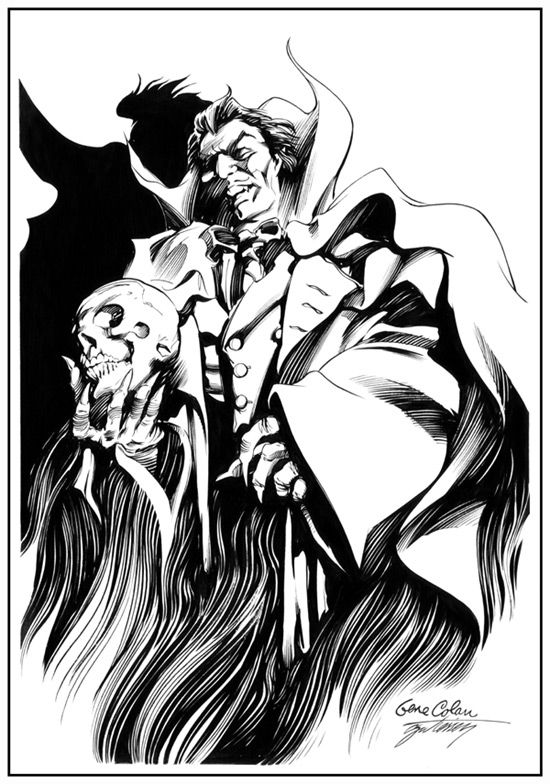
Art by Gene Colan.
While THE TOMB OF DRACULA wasn’t quite as intense as those 1950s horror comics, it was a good deal darker than Marvel’s regular offerings. For one thing, it’s one of the few long-running comic book series where the villain is the star. Count Dracula is the main character. He drives the action. He’s in the title, just like in, well, Bram Stoker’s Dracula. Of course, a creature like Dracula makes many enemies, and fairly quickly, a regular stable of vampire hunters, including Frank Drake, Dracula’s descendant, and Rachel Van Helsing, whose surname fans of Dracula may well recognize, all formed around the goal of ending the scourge of Dracula.
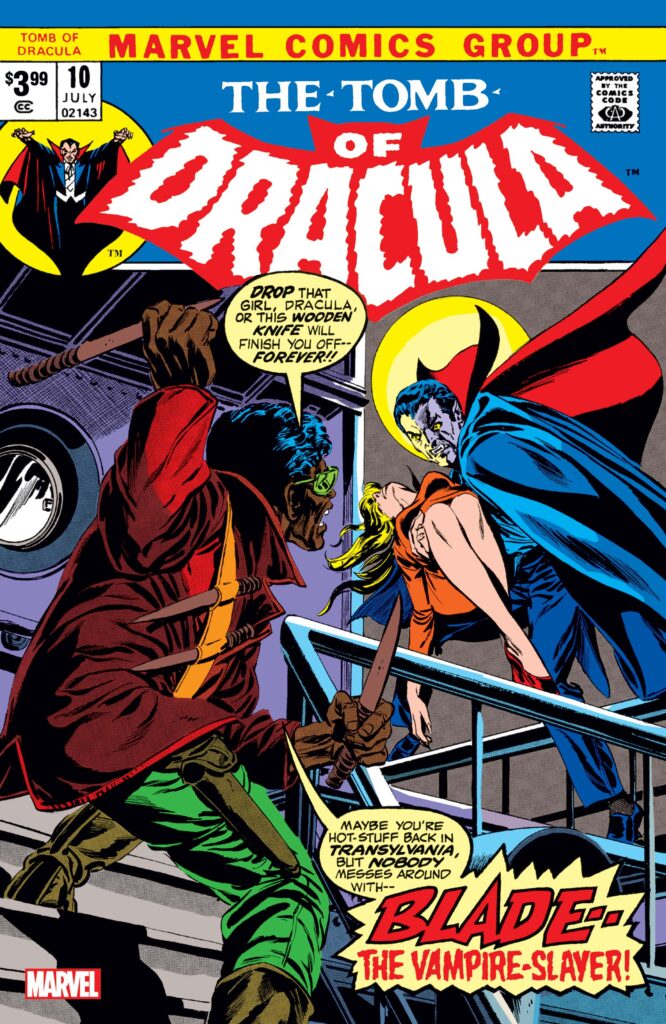
Cover by Gene Colan.
And then there was Blade. Marv Wolfman took over writing THE TOMB OF DRACULA with Issue #7, and Blade was introduced in Issue #10 in July of 1973. Blade was badass and boastful, bold and loud. He was a little bit SHAFT, seen pretty early on getting romantic (but not too romantic) with a love interest. Gene Colan based his appearance on the late Jim Brown. A lot of these elements are notably different than the much more terse rendition of the character we would come to know, but his basic origin is the same: His mother was bitten by a vampire while about to give birth, and so Blade was born with unique abilities, if not quite “All of their strengths, none of their weaknesses.”
Blade was an obvious standout in THE TOMB OF DRACULA. He really did give the Count a run for his money in multiple appearances, but after the series ended in 1979 with Issue #70, Blade wasn’t seen too much in any comics until the early 1990s, after Ghost Rider (another of Marvel’s great creations of the 1970s) returned, and suddenly there was a market again in comics for darker-edged heroes of the night.

Now we get to the movies. BLADE preceded Marvel Studios as we know it today. This was different leadership, in a different time. Superhero movies were fewer and further between. SUPERMAN was huge in 1978 and BATMAN was huge in 1989, but those guys have been on Underoos for decades. Everybody knows Superman and Batman. Outside of Spider-Man and possibly The Hulk, no Marvel character had that kind of worldwide name recognition all the way back there in the 1990s. Many people tried to make Spider-Man movies in the 1980s and the 1990s, but we didn’t get there until 2002. The Hulk followed in 2003. By then, the needed technology had caught up with the genre.
Blade didn’t need all that much technology. In that way, and in many others, he was a terrific, if unlikely, choice to arguably kick off the era of the superhero movie. Blade is a tough guy who kills vampires. Excellent. Movies can do that. Credit has to go to David Goyer for crafting that first script. Watching BLADE again, I was struck by how efficient the story is. It sets us down in a world where vampires exist and then drops in the lead character. Everything else, we can pick up along the way.

BLADE opens with a regular guy being led into a club by a fast-moving lady. Only too late does he realize he’s the main course for a party of a few dozen vampires. The guy is played by Kenny Johnson of THE SHIELD, and there’s nobody better at playing a likable doofus who’s in over his head. The lady is played by Traci Lords, who was super-famous in the 1990s (ask your dads) but whether or not you know that, she’s got a fierce charisma that makes you instantly understand why this dude is following her without thinking, but also makes you aware that it’s a real bad idea.
One of the vampires we meet in this opening race sequence is played by Donal Logue, who broke through as “Jimmy The Cab Driver” on MTV in the early 1990s and has developed over the years into a truly wonderful character actor, the kind who makes every project better and provides reason all on his own to see that project. You’d need a memorable actor here, because soon enough we meet our lead, who is played by Wesley Snipes.
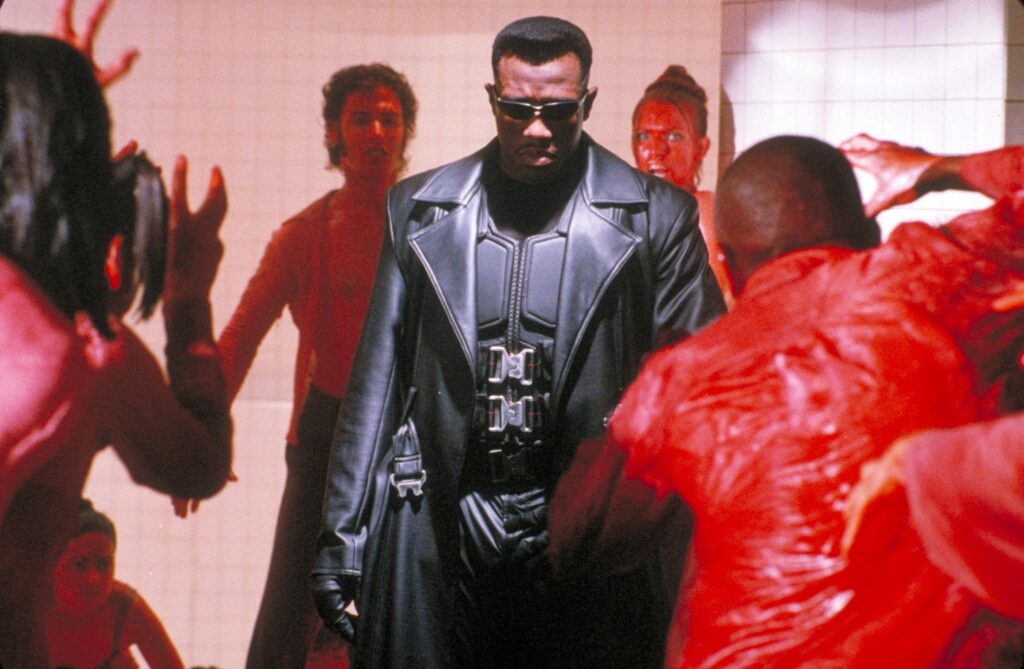
I don’t honestly feel the world has fully given Wesley Snipes his due. In the 1980s, we gained some of the great Black movie stars of all time. I’m thinking of Eddie Murphy, in comedy, and Denzel Washington, in drama. Wesley deserves mention right up there alongside talents such as these. He broke out early in films like WILDCATS and MAJOR LEAGUE, where he was lovable. KING OF NEW YORK and MO’ BETTER BLUES proved he could play against any dramatic heavyweight you threw at him. And then in 1991’s NEW JACK CITY, he does something remarkable with the role of Nino Brown. That’s a movie with three different heroes. Wesley plays the villain. Wesley is the guy you remember. No slight to those other actors, since I’m a fan of them all, but could you name them if I don’t do it here? When I say “NEW JACK CITY,” you think “Nino Brown.” For people of my vintage, Wesley Snipes as Nino Brown is our Al Pacino as Michael Corleone. I don’t think I exaggerate too much by saying that.
Wesley Snipes became a movie star by playing the villain. That doesn’t happen too often, and it’s the signature of a performer with volcanic charisma when he can play it so nasty and you’ll only love to watch him more. (I see echoes of what I said earlier about Dracula being the star of his novel and comic series…) Wesley proved he could be a romantic lead in JUNGLE FEVER and a comedic powerhouse in WHITE MEN CAN’T JUMP. He was back to being a bad guy in DEMOLITION MAN, where he was funny and scary in equal measure and totally irresistible, like an evil Bugs Bunny.
Wesley was a reliable action star throughout the 1990s, with PASSENGER 57, BOILING POINT, RISING SUN, DROP ZONE, MONEY TRAIN, MURDER AT 1600, U.S. MARSHALS, but to this day, along with John Leguizamo and Patrick Swayze, he does not get the credit that he deserves for daring to do drag in TO WONG FOO, THANKS FOR EVERYTHING! JULIE NEWMAR. You were not gonna see Stallone or Schwarzenegger do that. You wouldn’t see Bruce Willis do that. You sure as hell wouldn’t see Mel Gibson do it. The 1990s were a homophobic time. Trust me. I lived through it. Only the baddest of the bad could be that bold back then.
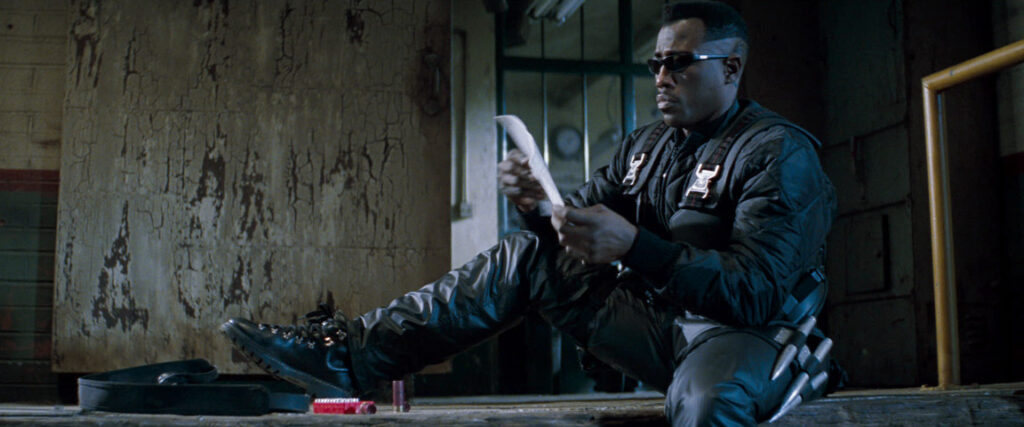
Wesley Snipes was perfect casting for Blade. Nobody else at that time could be so convincing, so sleek, so fluid, in action scenes while also being so compelling that he could win you over instantly with so little dialogue. Characters that don’t talk much are cool; that’s been true from Clint Eastwood to Snake-Eyss from G.I. Joe, but the terseness of Blade is based out of character. This is a man who grew up virtually alone. I love those moments where Wesley as Blade flashes a quick smile and then resets his face in stone — it’s funny, for sure, but also makes you think this is a person who barely knows how to relate to other people. He’s forcing a smile just because he knows smiles are something humans do to other humans sometimes. I’m still convinced that when Blade does this “Yes!” gesture it’s because the TV was left on one night and he saw Macaulay Culkin do it in HOME ALONE.
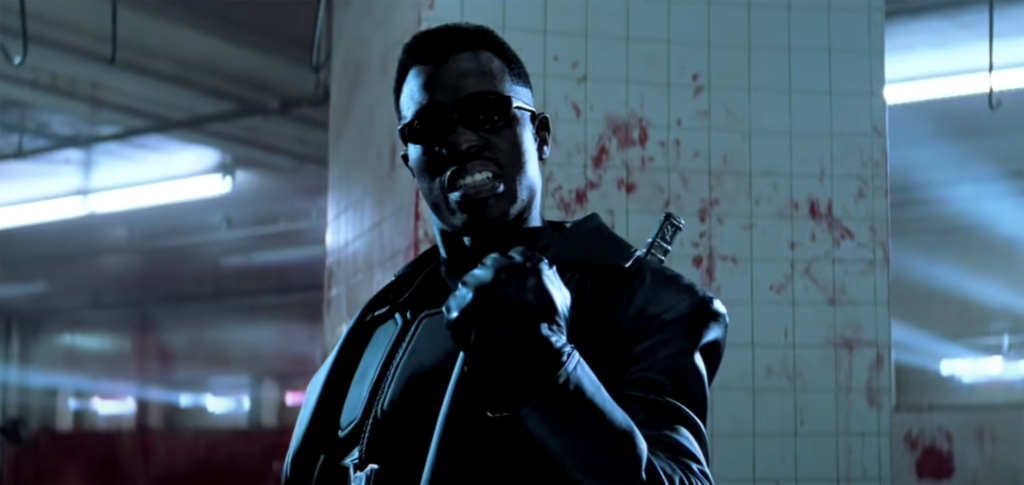
As I said, we get a lot of information early on in BLADE, but it’s a credit to Goyer’s script and the swift, brisk, energetic direction of Stephen Norrington that we the audience, whether or not we’ve ever read a Marvel comic, can keep everything in mind while thrilling to the action. And there’s so much action! I can remember seeing BLADE in the theater and feeling like we were seeing something new — not referring to the advent of mainstream superhero cinema, because this doesn’t even feel of a piece with that movement. This movie is more potent than that, to this day. I would argue it took the angst and moodiness of comic-book films (examples being BATMAN, TEENAGE MUTANT NINJA TURTLES, and THE CROW) and gave it a hit of Hong Kong cinema influence. It’s in the furious fight choreography, in which Wesley is clearly doing the movies, and in that way Norrington jerks the camera, but smoothly, every time anyone takes a punch or an elbow or a kick or a stake.
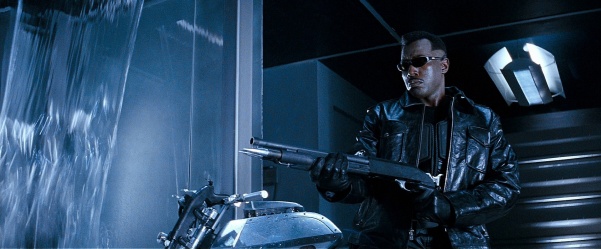
Going back to our overture at the rave, Blade is easily able to wipe out a clump of vampires, sending the rest running. He saves the sole human (interesting to note Kenny Johnson plays the “damsel in distress;” any other action movie of the time would give this role to a woman) and leaves the Donal Logue vampire pinned to a wall, on fire. Like Batman, Blade is clambering out a window as the cops arrive.
The action shifts to the morgue, where personnel on duty receive a charred body that isn’t as dead as they think. Donal Logue kills one guy and bites his colleague, a hematologist played by N’Bushe Wright, an actress who I really liked here and in 1995’s DEAD PRESIDENTS but who hasn’t appeared in anything in over five years. (I wonder why! Seems a shame.) She isn’t turned, since Blade has followed the vampire and interrupts his feeding. Donal Logue is funny in this movie since he keeps getting tore up by Blade but keeps managing to survive, barely. He runs back to his boss, Deacon Frost, who is played by Steven Dorff in maximum douche mode. Frost is a character in TOMB OF DRACULA but not like he is here. He’s an older guy in the comics. Maybe the filmmakers figured there were already enough old guys in this movie and decided to go younger.

Meanwhile, Blade takes the doctor, who is wounded but alive, back to his headquarters. There, he introduces her to Whistler, who is his only friend, his weapons-forger, his father figure, the man who found him in his youth and spared him. Whistler is a crusty old coot, immaculately conjured by Kris Kristofferson. With every year that passes, I am more a fan of Kristofferson, pioneer of outlaw country, boxer, pilot, philosopher, movie star, lyrical genius. His is one of the great lives in American culture. This movie is elevated by his presence. Surprisingly, or maybe not so much, he and Wesley have a believable connection. Rebel recognizes rebel. It’s not an “easy chemistry,” because it’s not supposed to be, but there is not a moment between them in this movie that is not believable, and even with a lovely lady in the mix, Whistler and Blade is the love story of this movie.
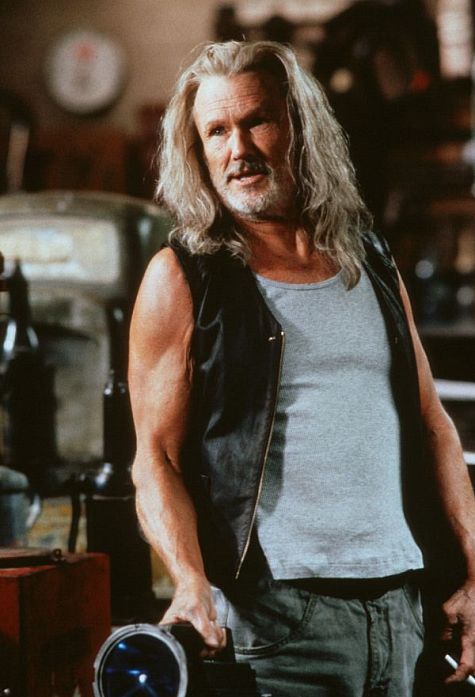
I’m not going to go through the film scene by scene, but I did want to make note of some of the observations I had with it this time around. I’m struck by, as much as it departs from superhero movies of the time, how much it owes to what went before. In the way Blade takes Karen Jenson to his hideout to meet Whistler, so does Batman take Vicki Vale to the Batcave to meet Alfred, so do the Ninja Turtles take April O’Neil to the sewers to meet Splinter. And just as Deacon Frost asserts his dominance over the council of elder vampires by running their boardroom and later executing one of their number (played by amazing face Udo Kier), so did Jack Napier/ The Joker do with members of the underworld in BATMAN. (“Got a live one here!”) I guess you can’t depart from norms without also echoing them.
And as much as BLADE built upon its genre, so did it anticipate future trends. But again, it’s not the superhero-movie genre I’m referring to. Keep in mind this movie came out a year before THE MATRIX. Visually, Blade has more in common with Neo — dark glasses, black leather, trench coat — than anyone in any Marvel film. The flurry of fights in BLADE have more in common with THE MATRIX than X-MEN, as do its ideas of evolution. BLADE’s innovations and aesthetics, along with another 1998 film, DARK CITY, predicted THE MATRIX, which in turn rewrote American action films for at least a decade. And it’s more than fair to say that without the success of BLADE, we would not have something like 25 years of superhero adaptations in movies, for better or worse.
But in that light, BLADE still feels like an anomaly. It’s darker, sexier, even weirder than anything Marvel Studios has done. There were two BLADE sequels, with diminishing returns, but they had the courtesy to stop at three. (Guillermo del Toro’s Eurotrash-style outing was good fun, but BLADE 3 is lethally laden with Ryan Reynolds’ schtick, Jessica Biel’s visible disinterest, and a horrendously miscast antagonist I can only refer to as “Stallone Dracula.”)
One thing that never failed through three BLADE films was Wesley Snipes as Blade. Marvel Studios has recast the role, but they will only defang the character. I look to the ending of the first BLADE movie, which assures us that Blade is still out in the world, doing battle with the undead. I like to think that somewhere in the multiverse, similarly, Wesley Snipes got the chance to make twenty more BLADE movies. Really, I feel pretty sure he could make another one tomorrow if they’d let him. With a cameo from Kristofferson. Lord, what a dream.
In this universe, though, we’ve got BLADE, and thank La Magra for that.
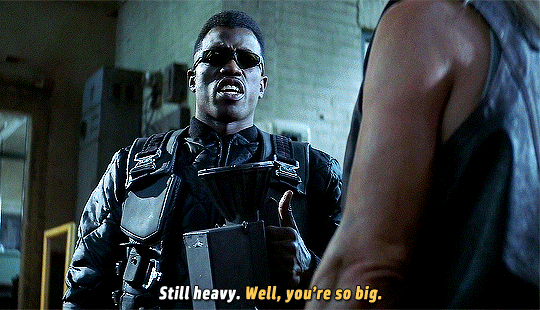
- [THE BIG QUESTION] WHAT’S YOUR FAVORITE FEMALE ENSEMBLE IN MOVIES? - July 22, 2016
- [IN THEATERS NOW] THE BOY (2016) - January 24, 2016
- Cult Movie Mania Releases Lucio Fulci Limited Edition VHS Sets - January 5, 2016
Tags: 31 flavors of horror, Amen Ra Films, Columns, David S. Goyer, Donal Logue, Gene Colan, Horror, Kris Kristofferson, Mark Isham, Marv Wolfman, Marvel Comics, Marvel Enterprises, N'Bushe Wright, new line cinema, Paul Rubell, Sanaa Lathan, Stephen Dorff, Stephen Norrington, The 1970s, The 1990s, Theo van de Sande, Traci Lords, Udo Kier, vampires, Wesley Snipes







No Comments